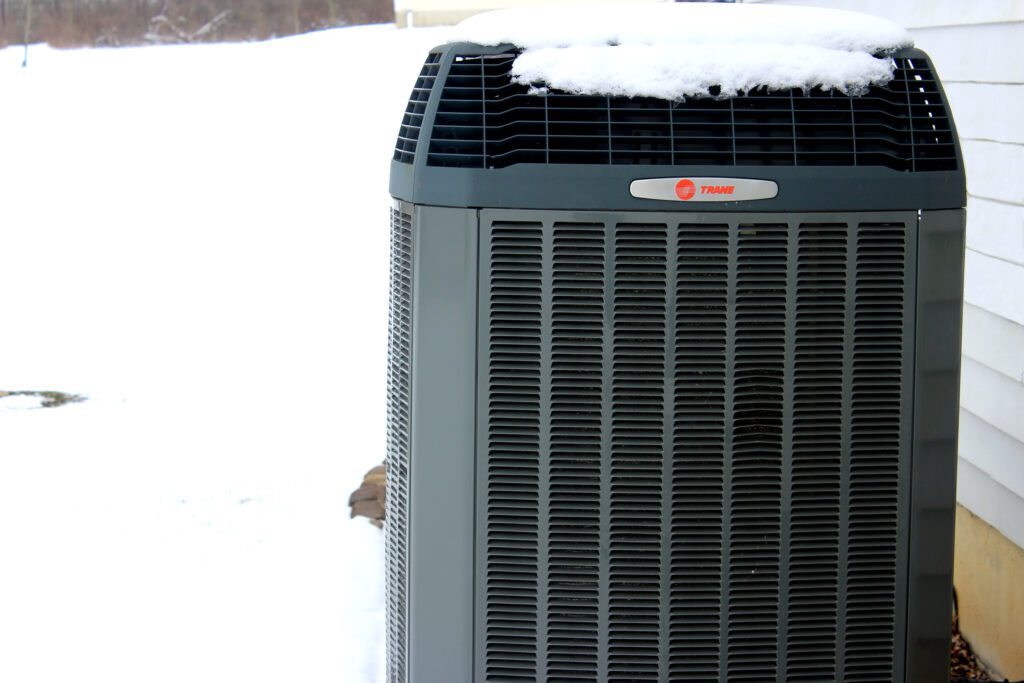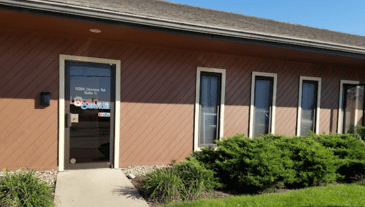Having your heat pump fan blades frozen can cause major problems with your system. In this comprehensive guide, we’ll cover what causes frozen fan blades, the issues they create, solutions to thaw and prevent freezing, and when to call in a professional for repairs. With preventative maintenance and awareness of what causes ice buildup, you can help keep your heat pump running efficiently all winter.
What is a Heat Pump, and How Does it Work?
First, let’s quickly cover what exactly a heat pump is and how it operates. A heat pump is an HVAC system that provides both heating and cooling by moving heat rather than generating it directly. It works by pulling heat from one area, called the heat source, and moving it to another, called the heat sink.
In cooling mode, the outdoor unit pulls heat from indoors and releases it outdoors. The refrigeration cycle uses a compressor, condenser coil, expansion valve, and evaporator coil to take heat from your home’s air and dissipate it outside.
For heating, the process is reversed – heat is extracted from outdoor air and pumped indoors. Heat pumps utilize fans both inside and out to circulate air through the system. The outdoor fan is critical for proper operation. When it becomes blocked or frozen, problems arise quickly.
What Causes Heat Pump Fan Blades to Freeze?
Due to several underlying issues, heat pump freeze ups occur when the blades are encrusted with thick ice. Awareness of common causes can help homeowners identify and address problems before severe freezing occurs.
Low Refrigerant Charge
An inadequate refrigerant charge is one of the most frequent reasons heat pump fans freeze. Refrigerant is the substance that circulates through the heat pump unit to transfer heat. When charge levels are too low, it prevents the refrigeration cycle from functioning properly.
With insufficient refrigerant, the evaporator coils can drop below the normal operating temperature range. This leads to coils icing up from moisture in the passing air. Ice accumulates on the coils and can spread to the fan blades and housing. A lack of refrigerant also reduces cooling capacity, forcing the unit to run longer to try to maintain set temperatures. This excessive runtime only exacerbates icing issues.
Checking and adjusting refrigerant charges requires specialized equipment and training. Homeowners should have an HVAC technician assess refrigerant levels at least once a year, before the heating season. Low refrigerant could be the reason if your heat pump seems to have reduced heating or cooling output.
Faulty Defrost Cycle
Heat pumps have an automatic defrost cycle that periodically melts away frost accumulation on the outdoor coils. A malfunctioning defrost system can allow ice to continually build up until it spreads to the fan. There are several defrost components that can fail and prevent proper operation:
- Defrost control board: This controls the timing of defrost cycles. If it malfunctions, defrost may happen too infrequently or not at all.
- Defrost thermostat/sensor: This monitors coil temperature and signals when a defrost cycle is needed. If it stays stuck open or closed, the unit won’t defrost properly.
- Defrost heater: The electric heating element that heats the coils above freezing to melt ice. If it burns out, defrost won’t be able to occur.
Each of these components may need to be diagnosed and replaced by a technician if defrost issues arise. The defrost system plays a crucial role in limiting ice buildup during heat pump operation.
Excessive Moisture
High humidity combined with freezing temperatures is a recipe for frosted heat pump coils and fan blades. Small amounts of moisture naturally present in the air passing over the heat pump’s cold coils and fins will condense and freeze. Under normal conditions, occasional defrost cycles clear this light frost buildup.
However, in very humid climates or wet weather, condensation and subsequent ice formation can overwhelm the defrost system. Large droplets of water in foggy, rainy, or damp outdoor conditions cling to the fins and fan. This moisture rapidly freezes solid in below-freezing air temperatures. Ensuring proper grading, drainage, and airflow around the outdoor unit is critical to limit excessive moisture exposure.
Extreme Cold Temperatures
Frigid outdoor temperatures increase the likelihood of heat pump freezing issues. When the mercury drops well below freezing, even small amounts of environmental moisture can swiftly turn to dense ice coatings on heat pump components.
The strain of extreme cold causes the system to run nearly continuously in an attempt to keep your home’s interior warm. This cycling exposes the outdoor coils and fans to freezing air almost nonstop. While heat pumps are designed to operate in cold climates, extended subzero temperatures put them at a higher risk of icing complications. Upgrading to a unit rated for very low temps may be beneficial in extremely cold regions.
Being aware of the conditions and underlying issues most likely to cause frozen fan blades allows homeowners to take preventative action when needed. If you notice these problems arising, schedule service before freezing and damage occurs.
Problems Caused by Frozen Fan Blades
Allowing heat pump fan blades to become coated with ice over the winter often leads to serious operational problems and equipment damage. Being aware of the most common issues can help stress the importance of preventative maintenance.
Greatly Reduced Heating Efficiency
One of the first and most noticeable effects of a frozen fan is a major reduction in heating output. The fan is critical for pulling warm air across the outdoor coils and circulating it into the home. When bogged down by heavy ice, the fan can’t turn at full speed or move sufficient air.
With the airflow obstructed, less heat can be extracted from the outdoor air to warm your home. You’ll notice uncomfortably low vent temperatures and likely cold spots in certain rooms far from the unit. Despite running for longer periods to compensate, an iced-up heat pump often can’t maintain your thermostat set temperature.
In addition to impacting indoor comfort, the reduced efficiency leads to higher energy bills. The heat pump has to work overtime trying to defrost and make up for inadequate airflow. The system will be in an almost continuous cycle of running inefficiently, attempting to defrost, and then icing up again. This results in very high kilowatt hours on your electric statement.
Excessive Strain on Fan Motor
The dense weight and friction forces caused by ice accumulation put a significant mechanical strain on the fan motor. This places extra wear and tear on its components and internal windings. Fan motors aren’t designed to contend with the heavy rotational resistance of fully iced blades.
You may hear odd groaning, buzzing, or grinding noises coming from the motor as it tries to turn despite being frozen up. This strain can cause overheating, voltage issues, and premature breakdown. Motors that are forced to continually labor against heavy ice often burn out far sooner than their normal lifespan.
Replacing a burned-out fan motor is one of the most common repairs needed on heat pumps affected by frozen blades. This can cost several hundred dollars in parts and labor. Avoiding icing conditions protects the fan motor from excessive strain.
Potential Complete Seizure and Destruction
In extreme cases, the cumulative friction and weight of ice on a heat pump fan essentially brings it to a standstill. Enough frost buildup over time can totally freeze the blades in place and completely stop the motor from turning.
When this “frozen solid” state occurs, the fan motor is subjected to its most dangerous failure mode – overheating while stalled. With no airflow for cooling and the windings locked in place by ice, internal temperatures rapidly rise. This quickly causes insulation breakdown and winding burns outs.
Within minutes, an overloaded frozen motor will burn itself out through overheating. When the windings fail, they can actually melt or spark, totally destroying the motor. Repairing a seized and burned-out fan motor often isn’t possible – a full replacement is required.
Allowing a fan to fully freeze leaves you not only with no heat but also a disabled heat pump requiring professional repairs. Catching icing issues early is crucial to avoid seizing and potential destruction of the fan motor.
Solutions for Thawing and Preventing Frozen Fan Blades
Routine Fan Blade Inspection and Cleaning
One of the easiest preventative measures is to periodically inspect the fan blades before winter hits. Look for any debris buildup, dirt, or moisture that could contribute to frost. Carefully clean off any leaves, grass clippings, dust, or other debris. A clean, dry blade is less prone to icing issues.
Check that the blades are undamaged and still secure. Make sure drainage holes are open and unobstructed. Performing this simple maintenance helps avoid many minor freezing problems over winter.
Confirming Proper Refrigerant Charge
As mentioned previously, low refrigerant charge is one of the most common causes of heat pump freezing. Have an HVAC technician verify the charge level before cold weather sets in.
Proper refrigerant pressures and temperatures are critical for efficient operation and to avoid component icing. The technician can top off the charge if needed. Annual checks also identify any leaks that may have developed in the sealed system.
Installing Hard Start Kits
Hard start kits provide a boost of starting torque to assist air conditioning compressors. This same technology can help heat pump fan motors overcome the heavy initial resistance of frozen blades.
The kit acts like a capacitor, providing a quick jolt of power to break the icy adhesion holding the fan. This allows the blades to begin slowly spinning and throw off the frost buildup through centrifugal force. Hard start kits are relatively inexpensive and can be installed by your HVAC technician.
Improving Drainage Around the Unit
Standing water, overflowing gutters, and excessive moisture promote freezer fan blades. Ensure proper grading slopes water away from the foundation.
Keep drain hoses, line sets, and weep holes clear of debris. Consider installing French drains or a gravel bed to prevent puddling around the unit after storms. Good drainage and airflow help dissipate ambient humidity.
Installing Fan Blade Heating Elements
Heating elements, like heat tape or cable kits, are extremely effective at preventing frost accumulation. Heating tapes affix directly to the fan blades to keep them at just above freezing temperature.
The warming effect prevents moisture from adhering and freezing. Heat tapes are safe for continuous operation and protect fans down to -20°F ambient conditions. They offer an automatic solution for the coldest climates.
Replacing Faulty Defrost Components
If your heat pump’s defrost system components are malfunctioning, a technician will need to diagnose and replace the failed parts. Common replacements include the defrost control board, defrost sensor/thermistor, or the defrost heater element.
This will restore the proper automatic defrost cycle needed to limit ice buildup on coils and fan blades. Don’t attempt DIY repairs on complex defrost systems – leave it to qualified professionals.
Additional Preventative Measures
Other solutions include periodically running the fan to slough off light frost, erecting weather barriers around the unit, upgrading to cold climate heat pump models, and avoiding extensions during extreme cold snaps. Discuss options with your technician to find the right solutions for your climate and conditions.
With vigilance and the right corrective steps, you can help keep your heat pump fan spinning freely all winter long.
Hiring a Professional for Repairs
If you are unsure of the cause or unable to clear fan blade ice buildup yourself, call an experienced HVAC technician. A professional has the tools and knowledge to fully diagnose issues and make necessary repairs.
They can check refrigerant levels, electrical components, defrost cycles, and drainage to pinpoint the real problem. Simply clearing ice repeatedly without addressing the root cause won’t provide a permanent solution. Leaving freezing issues unattended risks serious damage to the fan motor or compressor.
Trained technicians have access to manufacturer information and troubleshooting guides. They can also safely handle refrigerant recharging and electrical repairs. Don’t take chances attempting complex heat pump repairs without the proper training and equipment.
Dangers of Attempting DIY Defrosting
It may be tempting to try clearing ice yourself using scrapers, blades, or heat guns. This risks damaging fins, coils, fan blades, and electrical components. You could end up doing more harm than good.
Also, use extreme caution when working around icy electrical systems. Never use excess water or try to chip off ice by hand. Live power to the fan motor poses a serious shock hazard.
Leave defrosting fully frozen equipment to the professionals. Focus on preventative steps you can safely take as a homeowner instead.
Preventative Maintenance Before Winter
You can help prevent frozen fan issues by performing proactive maintenance in the fall:
- Have your heat pump serviced by a technician before winter. They can identify and correct any issues ahead of time.
- Replace air filters. Dirty filters reduce airflow needed to keep the unit operating properly.
- Clean debris and vegetation away from the outdoor unit. Trim back any encroaching branches or plants.
- Inspect cabinet seals and insulation. Repair any gaps or damage allowing cold air infiltration.
- Check that refrigerant lines are intact and not leaking.
- Ensure drainage is functioning and free of obstructions.
- Consider having a technician apply a corrosion inhibitor to protect the unit over winter.
With proper preparation in autumn, you can avoid many of the problems that lead to frozen heat pump fan blades when cold weather hits.
Signs Your Fan Blades May Be Frozen
Be alert for any of the following symptoms that indicate your heat pump’s fan may be frozen:
- Reduced heating capacity and temperature difference between vents.
- Unusual noises or strains coming from unit.
- Outdoor unit operates but fan isn’t spinning.
- Electrical humming but no fan motor starting up.
- Ice buildup on exterior housing and fan blades.
- High utility bills from system running overtime trying to defrost.
Take note if you experience any of these issues during cold weather. Catching freezing early provides the best chance to correct it before serious damage is done. Don’t hesitate to call in an HVAC technician at the first sign of trouble.
Frozen Heat Pump Fan Blades – FAQs
Heat pump owners often have similar questions about dealing with frozen fan blades in winter. Here are answers to some of the most frequently asked questions:
How cold does it have to be for a heat pump fan to freeze up?
Fans can begin to frost and ice over when temperatures drop below 45°F. Below freezing conditions dramatically increase risk of freeze up.
What temperature should I run the auxiliary heat?
As a rule of thumb, you’ll want to use auxiliary heating once outdoor temps remain below 25-30°F for an extended period. Check your manual for specific guidance.
Can I break ice off the fan myself?
No, never attempt to break or chip ice off a frozen fan blade. This risks damaging the fan and poses an electrocution hazard.
How much does it cost to repair a frozen heat pump?
Costs vary, but expect $200 – $600+ to diagnose issues, replace damaged parts, recharge refrigerant, etc. Preventative maintenance is more affordable.
Should I turn off a heat pump if the fan freezes?
Only turn it off if you detect electrical issues like burning smells, odd sounds, or flashing unit lights. Otherwise, leave it on while waiting for technician.
What is the fastest way to defrost a frozen coil?
Using the reverse cycle Defrost mode is the fastest way to safely clear a frozen evaporator coil. This uses the heat pump itself to melt ice.
Can I cover my heat pump to prevent freezing?
Yes, weatherproof covers are made specifically for protecting outdoor heat pump units from icing over in winter.
Correctly diagnosing and addressing frozen heat pump fan blades requires both expertise and caution. If your fan shows signs of freezing, contact a qualified HVAC technician right away. With preventative maintenance and quick response when issues arise, you can help your system operate smoothly all throughout the cold winter months.





















